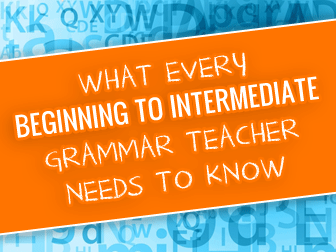Beginning level grammar may be easy, but teaching it to speakers of other languages is a challenge in and of itself.
Before you walk into that classroom full of beginning students or continue with them into an intermediate class, make sure you can explain these grammatical structures.
Teaching Grammar? Here's What You Should Know
-
1
How to Make Your Grammar Lessons a Little More Interesting
Because students new to the English language have so much to learn, beginning and intermediate students will need more time with straightforward grammar lessons. Still, that is no reason to settle for a boring class! Try these ideas for spicing up grammar class to keep both your students and you more interested until the bell rings.
-
2
How to Teach Boring Grammar Points: 7 Quick Proven Tips
Grammar does not have to be boring, even if you teach your students grammar lessons on a daily basis. Here are some ideas you can use to liven up those syntactical moments.
-
3
How to Teach Present Simple to Complete Beginners
You have showed up for your first beginning grammar class, and so have your students, but where do you start? This article will take you through the process of teaching the simple present tense to your beginning level students.
-
4
How to Teach the Simple Past – Regular/Irregular Verbs
One step forward, one step back? Once your students have mastered the simple present, move on to the simple past with this walkthrough. This article guides you step by step through everything your students need to know about the past for both regular and irregular verbs.
-
5
How to Teach the Simple Future Tense
Now that your students are comfortable with the simple present, it is time to talk about things that are to come with the simple future tense. This article will walk you through step by step as you teach your students how to talk about the future.
-
6
The Future May Bring…These Future Tense Activities for Class
Now that you have gone through the basics of the future tense, give your students a chance to practice with these classroom activities. They may enjoy talking about the future of television, technology or their own futures, and everyone is sure to learn something in the process!
-
7
How to Teach the Present Continuous Tense
You are moving your students from the simple tenses to the continuous or progressive tenses. Now what? Here you will find easy instruction for walking your students through the first of the continuous tenses in English and start talking about what you are doing right now.
-
8
How to Teach the Past Continuous Tense
So you and your students have tackled the first of the continuous or progressive and now you are ready to move on to the next. Walk your class through the past continuous as they discuss actions that were in progress at a certain moment in the past. Here is how to do it.
-
9
How to Teach the Future Continuous Tense
Simple past – check. Simple present – check. Simple future – check. Future continuous – we will be checking that tense off soon! This article takes you step by step through the process of teaching this intermediate level verb tense to your ESL class.
-
q
Verb Talk: Conversation Activities to Practice Using Verb Tenses
Knowing verb tenses on paper is one thing, but being able to use them in conversation is something very different and often more challenging. Give your beginning and intermediate students a chance to practice speaking of the present and past with these conversation activities that you can tie into any lesson.
-
w
Ten Teacher Tested Tricks to Teach Modal Verbs
Modal verbs, those that require another verb for their meaning, are challenging to second language learners, so the sooner you start incorporating them into your class the easier time your students will have. Here are some ideas for teaching these tricky verbs to your students.
What grammar topics are essential for your beginning and intermediate classes?
Tell us what has worked in your classes and what you wish other teachers would share!
P.S. If you enjoyed this article, please help spread it by clicking one of those sharing buttons below. And if you are interested in more, you should follow our Facebook page where we share more about creative, non-boring ways to teach English.








